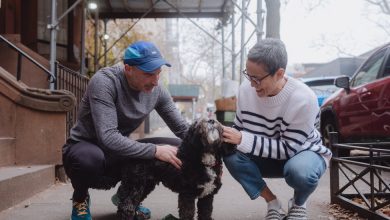As Art Dealers Descend on Seoul, One Looks Farther South

SEOUL — On a recent morning, Hyeryung Ahn sat in the top-floor office of her Leeahn Gallery in the art-filled Seochon neighborhood of Seoul, discussing how she balanced her dual roles as a collector and a dealer in the Korean art world.
“I don’t necessarily need to manage my time,” Mrs. Ahn said playfully. “Most of the great things I have collected have been impulse purchases. I can’t help it.”
A few of Mrs. Ahn’s holdings were arrayed around her, such as a Franz West sculpture resembling a paint-spattered boulder and a compact mountain of white cubes by Sol LeWitt, both protected inside translucent cases.
Behind her was a luminous painting that suggested weathered, black and white coral — hanji paper layered atop charcoal, then hit with a wire brush by Lee Jin Woo. He is one of the half-dozen artists, all Korean, represented by Leeahn, which Mrs. Ahn opened in 2007 in the southeastern city of Daegu. (Her three-floor Seoul location followed in 2013; an Antony Gormley sculpture of a nude man stands on its roof.)
An Andy Warhol show inaugurated the Daegu headquarters, establishing Mrs. Ahn, 64, as a source in South Korea for work of artists from abroad. American giants like David Salle, Alex Katz and Elizabeth Peyton have had their first solo outings in the country with her. Now, as galleries from outside South Korea quickly enter the nation — Pace Gallery, Tang Contemporary Art, Lehmann Maupin and Gladstone Gallery have opened branches, or relocated to far larger venues, over the past year in Seoul — Mrs. Ahn is building big in Daegu. The city, which is about two hours away from Seoul by high-speed rail and home to 2.5 million, has far fewer exhibition spaces than the capital.
Leeahn plans to unveil an expansion there in the summer of 2023, with 15,000 square feet across five floors designed by the architect Pil Joon Jeon, and a show by the German artist Imi Knoebel. Along with new exhibition space, it will feature an auditorium for lectures about art and collecting. A proud booster of her adopted city, Mrs. Ahn is also chairman of the Galleries Association of Daegu, which runs an annual art fair. She has advised many of the city’s collectors, and said, speaking via an interpreter, “Rather than follow the market, they go toward their own sense of what truly is art.”
Mrs. Ahn has also made her own way into art. Growing up, she said, her parents dissuaded her from becoming an artist. Instead, she studied mathematics and taught the subject at a high school. She began collecting after marrying, encouraged by her husband, Sung Doo Lee, a doctor of traditional Korean medicine. “Because he supported me when I first started collecting, I was nice enough to put his name first” in Leeahn, she said. (His work led the couple to settle in Daegu; Mrs. Ahn is from Masan, on the southern coast, and had been living in Seoul.)
Her move into dealing came in 2006. After the death of Lee Tae, the owner of an important Daegu gallery called Ci-Gong, she acquired it, and it became Leeahn.
“She’s not just in business,” Yoon-Hee, a sculptor and painter who goes by one name and has had work shown by Ci-Gong and Leeahn, said via email. “She is passionate, and wants to stand up for the things she enjoys.”
When Mrs. Ahn was only a collector, she “told me that she appreciated my work at that time, but that she couldn’t buy it because my sculptures were so large,” said Yoon-Hee, who is 72 and based in the south of France. Leeahn is hosting its third show with her — explosive abstract paintings of a single color against white — before a June exhibition at the Ludwig Museum in Koblenz, Germany.
The New York-based artist Jacob Kassay, who makes alluring monochromatic paintings (white, reflective silver), recalled being approached by Leeahn in the mid-2010s, as another potential figure to introduce to South Korea.
“I wasn’t sure a show in Korea was the right thing to do at the time,” he said in a phone interview. “It took three years for me to say yes,” he added, and the gallery’s willingness to wait “was part of the charm” of doing the show.
Patience is something that Mrs. Ahn counsels to her buyers. “Some collectors these days are very sensitive to the price,” she said. “When it goes down or it goes up, they sell the artwork too early. They don’t hold onto their collection or consider it special. Some of them treat it as a way to earn money only. So I really hope that people will appreciate art more, and that is why I want to educate people to see art as it is.”
She remains an active buyer herself, and her more than 1,000 works include present market powerhouses like Amoako Boafo, a Ghanaian painter of lucid portraits, and George Condo, an American who makes brash, surreal, cartoonish pictures and sculptures. On the gallery front, Mrs. Ahn said her focus now was on building the international reputation of the multigenerational artists she works with. They include Lee Kun-yong, a pioneer of performance art who makes paintings that record his movements, and Kwangho Lee, an inventive midcareer designer known for stools and benches made from silk and nylon rope. She sees the arrival of European and American galleries in Seoul, some representing foreign artists she has presented before, as an opportunity for Korean artists to make connections abroad.
Her own art holdings are a kind of backstop for Leeahn. If the time comes when her artists are not selling well, Mrs. Ahn said, “I would have to sell my personal collection so that we can continue to run the gallery.”
But business seems to be robust right now, she said. With Art Basel Hong Kong approaching, the gallery said that more than half of the work in its booth had already been spoken for and would soon be off to new homes.
As for Mrs. Ahn’s own collecting, she said, she has a standard practice when she does choose to part with one of her pieces. “I buy another one in order to disperse my love of art to other works,” she said.





